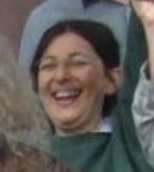Michèle Sebag
Martine-Michèle Sebag is a French computer scientist, primarily focused on machine learning. She has over 6,000 citations.[1]

Sebag studied mathematics at the Ecole Normale Supérieure, and later worked in the computer science industry, starting at Thomson Corporation,[2] where she was introduced to artificial intelligence. She then moved into the research field, at the Laboratoire de Mécanique des Solides at Ecole Polytechnique.
She was awarded a PhD from the University of Paris-Sud, Paris Dauphine University and Ecole Polytechnique. Sebag started work at the Centre national de la recherche scientifique (CNRS) as a research fellow in 1991.
Sebag is deputy director of the Laboratoire de Recherche en Informatique at the CNRS; Head of group A-O at the latter; co-head of Projet TAO at INRIA Saclay; and principal scientist at the CNRS.[3]
She was named chevalier of the Légion d'honneur in 2019.[4]
Selected research
- Gelly, Sylvain, et al. "The grand challenge of computer Go: Monte Carlo tree search and extensions." Communications of the ACM 55.3 (2012): 106-113.
- Bordes, Antoine, Léon Bottou, and Patrick Gallinari. "SGD-QN: Careful quasi-Newton stochastic gradient descent." Journal of Machine Learning Research 10.Jul (2009): 1737-1754.
- Termier, Alexandre, M-C. Rousset, and Michèle Sebag. "Treefinder: a first step towards xml data mining." 2002 IEEE International Conference on Data Mining, 2002. Proceedings.. IEEE, 2002.
- Sebag, Michèle, and Antoine Ducoulombier. "Extending population-based incremental learning to continuous search spaces." International Conference on Parallel Problem Solving from Nature. Springer, Berlin, Heidelberg, 1998.
Further reading
- José L. Balcázar; Francesco Bonchi; Aristides Gionis; 2010. Machine Learning and Knowledge Discovery in Databases: European Conference, ECML PKDD 2010, Barcelona, Spain, September 20–24, 2010. Proceedings. Springer. ISBN 978-3-642-15939-8.
- Taras Kowaliw; Nicolas Bredeche; René Doursat; 2014. Growing Adaptive Machines: Combining Development and Learning in Artificial Neural Networks. Springer. ISBN 978-3-642-55337-0.
References
- "Michèle Sebag". Google Scholar. Retrieved 18 August 2019.
- "Chercheuse tout-terrain : Michèle Sebag, responsable de l'équipe apprentissage et optimisation du LRI-CNRS". L'usine nouvelle. Retrieved 18 August 2019.
- "Michele Sebag". Laboratoire de Recherche en Informatique (LRI). Université Paris-Sud. Retrieved 18 August 2019.
- Mourgere, Isabelle. "Légion d'honneur du 1er janvier 2019 : une promotion sous l'ère de la parité". TV5Monde. Retrieved 18 August 2019.